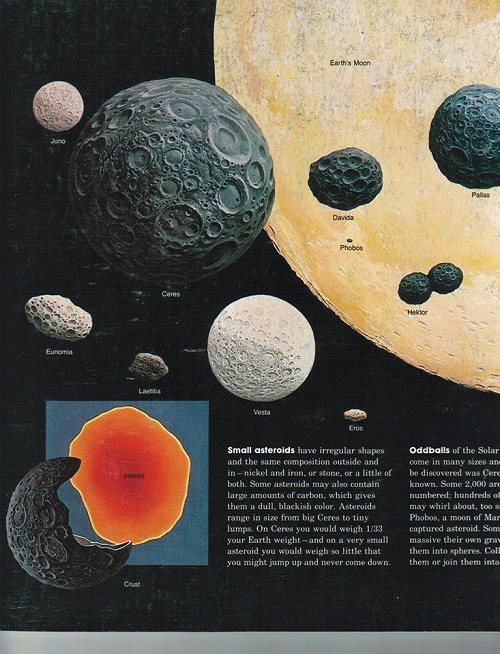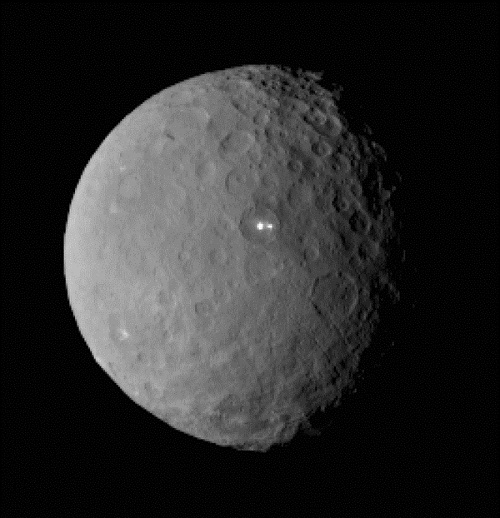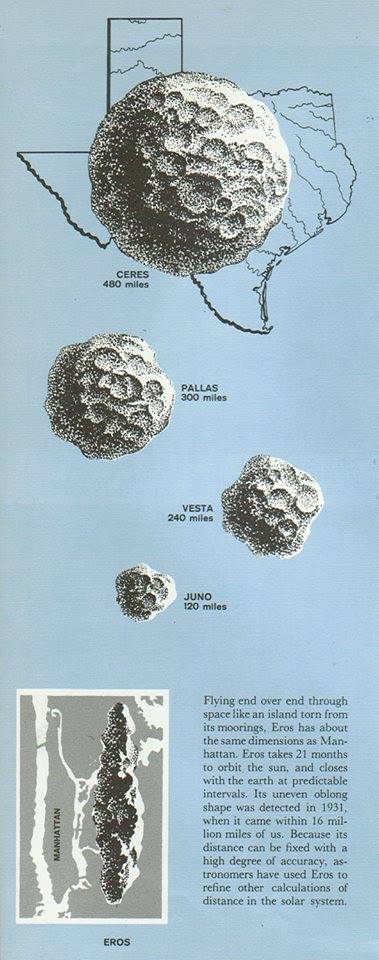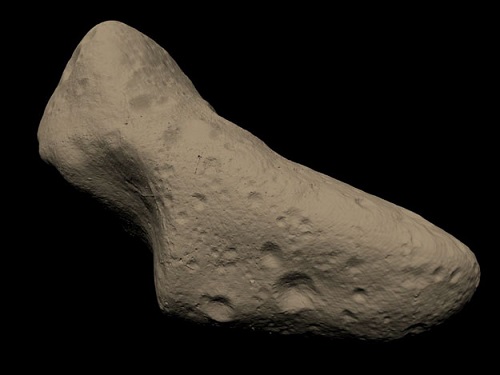I’m interested in how we depict astronomical objects, a fascination dating back to a set of Mount Palomar photographs I bought at Adler Planetarium in Chicago when I was a boy. The prints were large and handsome, several of them finding a place on the walls of my room. I recall an image of Saturn that seemed glorious in those days before we actually had an orbiter around the place. The contrast between what we could see then and what we would soon see up close was exciting. I was convinced we were about to go to these worlds and learn their secrets. Then came Pioneer, and Voyager, and Cassini.
And, of course, Dawn. As we discover more and more about Ceres, the process repeats itself, as it will again when New Horizons reaches Pluto/Charon. Below is a page from a book called Picture Atlas of Our Universe, published in 1980 by the National Geographic. Larry Klaes forwarded several early images last week as a reminder of previous depictions of the main belt’s largest asteroid, or dwarf planet, or whatever we want to call it. Here the artwork isn’t all that far off the mark for Ceres, though Vesta would turn out to be a good deal less spherical than predicted. No mention of a possible Ceres ocean in the depictions of this time; all that would come later.

Image: Ceres and other asteroids as seen through the eyes of artist Davis Meltzer in 1980, with the Moon as a background.
The recent Dawn imagery has us buzzing about the two bright spots on Ceres that, of course, were unknown to our artist in 1980. From 46,000 kilometers, all we can do is admit how little we know, which is more or less what Andreas Nathues, lead investigator for the framing camera team at the Max Planck Institute for Solar System Research (Gottingen) does:
“The brightest spot continues to be too small to resolve with our camera, but despite its size it is brighter than anything else on Ceres. This is truly unexpected and still a mystery to us.”

Image: This image was taken by NASA’s Dawn spacecraft of dwarf planet Ceres on Feb. 19 from a distance of nearly 46,000 kilometers. It shows that the brightest spot on Ceres has a dimmer companion, which apparently lies in the same basin. Credit: NASA/JPL-Caltech/UCLA/MPS/DLR/IDA.
Chris Russell, principal investigator for Dawn, speaks of a possible “volcano-like origin” of the two bright spots, but adds that we have to wait for better resolution to make any serious geological interpretations. The wait won’t be all that long (for better resolution, at least) given that we’re just days away from entering orbit on March 6. Could there be a better approach to this small world than this one, already focusing on something no one had expected to see?
In 1961, in an illustration from The Universe (New York: Morrow), we find Ceres again displayed with companion objects like Vesta and Pallas (I’m afraid I don’t know the name of the artist). Here the round, cratered Ceres is reasonably accurate, and you’ll note the size comparison, with Ceres tucked up inside Texas. At the bottom of the image is Eros, shown here as an object the size of Manhattan and described in the caption as “Flying end over end through space like an island torn from its moorings…”

And here is Eros as it appeared in the Astronomy Picture of the Day in 2001.

Image: Orbiting the Sun between Mars and Earth, asteroid 433 Eros was visited by the robot spacecraft NEAR-Shoemaker in February of 2000. High-resolution surface measurements made by NEAR’s Laser Rangefinder (NLR) have been combined into the above visualization based on the derived 3D model of the tumbling space rock. NEAR allowed scientists to discover that Eros is a single solid body, that its composition is nearly uniform, and that it formed during the early years of our Solar System. Credit: NEAR Project, NLR, JHUAPL, Goddard SVS, NASA.
When we get cameras in the vicinity of objects that for so long were just smudges in even the best telescopes, we sometimes find ourselves surprised and delighted, as witness the volcanoes of Io or, for that matter, the cryovolcanism and ‘canteloupe terrain’ on Neptune’s moon Triton. Sharpening the view takes us out of the realm of the artist’s imagination and into the world of concrete measurement. Giving up earlier visions can be poignant, as we learned with Mariner 4’s 1965 flyby of Mars, when a vegetative and even fertile Mars suddenly became a fantasy forever lost. But as Ceres is proving right now, the discovery of the unexpected is a much greater reward.



Landing lights….
Two mysterious lights. Glad we don’t have to wait 20-30 years for a new probe to be funded, designed, and sent. At least I hope we don’t. Could it be just ice reflecting sunlight from an underground ice-sheet that was exposed by an impact?
Just two weeks ago or so, I read posts about this world as “look another dumb boring rock we wasted money on”. Now internet is buzzing about this unexplained mystery.
To me Ceres was always a fascinating world with enormous promise of potential. The bright spots just add to its attractiveness and I hope we will see more of them soon.
It is also a reminder to us that most of our Solar System itself remains unexplored and holds many mysteries and wonders.Even as we debate other solar systems and planets, our own backyard so to speak remains a treasure trove we barely looked at.
I am glad Triton was mentioned in the post. Another fascinating and incredible world with complex geological and atmospheric reactions, we haven’t even seen in full! And yet there is no probe or mission dedicated to it…
The near future has missions to Jupiter, but sadly lacking missions to Saturn and Neptune which are own mini-worlds with very attractive moons waiting to be explored.I really hope that after JUICE and JUNO we will see a mission to Saturn(Titan and Enceladus in early 30s) and then Neptune.
For the time being let us enjoy the images of Ceres and hope that the Chinese will decide to fund their sample retrieval mission.
Ten bucks says it’s a Bracewell probe. We will of course need to land next to it and do a little bit of excavation in order to set it off. I suggest sending men instead of chimps.
The latest imagery
http://dawn.jpl.nasa.gov/multimedia/Ceres_Awaits_Dawn.asp
Apparently the lights abruptly switch on and stay on right into the terminator. How odd.
The latest imagery viewed. Wow! The two super bright spots are not at all similar to the ordinary light spots seen elsewhere. Specular reflection from glassy smooth icy surfaces is the only plausible answer.
It might be Robinson Crusoe and Fridays camp fires, they have had an argument and that is why the fires are apart.
In reality it could be salt deposits left over from when salty water/ice moved up from below and were left behind after the water sublimed, the depsoits now reflect light and to some extent fluoresces.
NASA Jet Propulsion Laboratory press conference on Dawn Ceres Arrival. Worth to have recap on Vesta / Ceres results for now.
https://www.youtube.com/watch?v=sJr-pctUYdw
The bright spot is still unresolved, less wide than the 4km pixel size on the most recent images. That means it is very reflective – a patch of freshly exposed icy material seems probable. Perhaps a landslide removed the top of that craters central peak?
Re those bright spots – It’s got to be ice. I think everyone knows this. But I don’t think I’d be speaking incorrectly if I also said that a lot of people deep down will probably wish it was something more ‘exotic’. Perhaps not natural?
Let’s just speculate hypothetically that Dawn gets detailed imagery and it’s clearly an artificial structure. How would that affect human affairs back on Earth? If it were something of extraterrestrial origin, perhaps millions or billions of years old, and clearly technological in nature, how would that impact on social order or religion, or politics or economics? It would be clear evidence of an independent evolution of life. That s significant development for humanity (read Paul Davies ‘The Eerie Silence’ where he goes into this.)
Then the question would be how would we respond in terms of follow-up missions to learn more. Dawn would be insufficient and additional probes would need to be sent, and I’d assume, there would be real urgency to do so. Would we eventually send a crewed mission? I’d hope so!
Of course, I’m speculating. It will probably be ice. I’m pretty certain of that. But part of me, the part that allows me to leap beyond the rigid constraints of science to wonder what is out there and are we alone, hopes that the lights of Ceres are something a bit more interesting.
Here’ my take. The smaller of the two bright spota is CLEARLY SITUATED on the easternmost part of the rim of the crater containing the two spots. NASA scientists have apparently COMPLETELY RULED OUT a volcanic origin for the largest spot, due to lack of any kind of relief (UP OR DOWN) on the crater floor (I was SO HOPING FOR a lava dome, like the one at Mount St Helens, but made ENTIRELY OF ICE)! But, with the crater ENTIRELY TO THE EAST of the terminater, and in COMPLETE SHADOW, the large bright spot is STILL CLEARLY VISIBLE! The only explanation I have for this is a Guyser plume that never reaches ABOVE the crater wall! This guyser CANNOT BE ON ALL THE TIME, like the ones onEnceledus, but more like Old Faithfull. Due to Ceres’ higher gravity, the ice rises only a few kilometers before it starts to fall, but does not ENTIRELY REACH THE SURFACE before the NEXT eruption. Therefore you have RISING ICE and FALLING ice COLLIDING WITH EACH OTHER, which somehow pushed SOME of the ice to the EAST to COAT the crater rim.
Watch Ceres rotate: A guide to interpreting Dawn’s images
Posted By Emily Lakdawalla
2015/03/03 20:55 UTC
NASA held a press briefing on the Dawn mission yesterday, sharing some new images and early interpretations of them. The new images include a total of 27 from the Rotation Characterization 2 sequence that I discussed last week, as well as their first global map made by combining these 27 images in a mosaic. I spent yesterday playing with these photos, trying to decide what to write about them. I see lots of things that intrigue me, and I’m looking forward to Dawn investigating them in more detail.
There are lots of places where crater floors are not the shape I expect. There are lots of subtle linear topographic features that might not be related to craters, but it’s hard to say. I’m hesitant to write about these subtly intriguing features, because I feel like I indulged in speculation enough in my previous post on Dawn’s photos; it seems premature to try to draw any more conclusions.
So instead of writing another lengthy post interpreting the images, I invite you to check out these photos yourself, and offer you some guidance on things to look for. First, just appreciate the full rotation animation. Take a moment to imagine yourself as Dawn, watching Ceres rotate leisurely below you over the course of its 9-hour day.
Full article here:
http://www.planetary.org/blogs/emily-lakdawalla/2015/03031236-watch-ceres-rotate-a-guide.html
Malcolm, you paint an amazing picture. Wow… think how NASA’s ARM might get radically altered, after a call to Mr Musk, to a Ceres rendezvous.
In the 1980 image of Ceres the artist has even captured the dwarf planet as having a dichotomy in the extent of heavily cratered terrain bordering smoother areas… a fact revealled by Dawn just recently.
More than likely ice domes from water welling up from below that reflect light efficiently to the sides, but on such a small world which should have frozen solid long ago, intriguing. Now they can’t be very old as the ice would have sublimed and/or have been covered with the ample amount of dust that rains in from the asteroid belt. Rovers please!
A link to the smoother basin image I refer to above
http://www.planetary.org/multimedia/space-images/small-bodies/ceres-20150219-big-basin.html
Mark,
It would be an interesting development in terms of how it would re-prioritise the objectives of not just the US but other nation’s space programs. I think it would actually be very good for proponents of thinking about interstellar flight because there would be a natural desire to get back to Ceres as quickly as possible – rather than take decades just to put the pieces in place, I can envisage a ‘race to Ceres’ approach setting in, particularly if the ‘artefact’ were seen to be of technological origin. Clearly this is one scenario that could go either way – an international collaborative effort – or a race to grab alien technology for national advantage. I’d hope it was a collaborative effort to benefit all of humanity.
In terms of getting there, we could not do a typical profile Mars mission and go a bit further out to Ceres. This is the problem with thinking about human spaceflight beyond Mars… the travel time increases dramatically, whether its to Ceres or to study possible biological life in the Europan oceans. If we are sending people they have to get there quickly. So chemical rockets and gravity assist, or even ion propulsion won’t cut it – they are too slow and Ceres is too far, for a human mission. I’d say it would have to be nuclear-electric propulsion as the only choice. But as I note above, maybe intersteller proponents could then step into the breach, and look at near term (as in within 30-40 years) for using interstellar type propulsion to at least get fast interplanetary trips.
I have to keep saying – its probably ice. But I think the one thing that makes me wonder though is the fact that the lights are visible even past the terminator. If it were just ice, how is that possible? Unless its a tall ice mountain that is catching sunlight above the limb of Ceres? Someone above suggested geysers as a possibility, but these lights ‘stay on’ and seem to have constant brightness. Would not a geyser’s brightness level wax and wane as it pulsed? Cryo-volcanoes have been ruled out by JPL. So what’s left?
I think its important not to jump to conclusions that you want to emerge. People make the same mistake with landforms on Mars – they see faces and pyramids where there are none. So as weird and unexplained the lights of Ceres are, its important to remain detached and focused on explaining them through natural causes, before we start speculating about something else. But I’d imagine very few scientists would not have inwardly engaged in some speculation on these lights.
Malcolm,
I agree. The race would be on and while I realize an Orion/Dragon combo would never cut it, there would likely be the explosion in R&D you predict. I’d love for it to be artificial along the lines of say, the crystal pyramid from A C Clarke’s ‘Sentinal’, but the much more likely scenarios are still going to be amazing. My guess is that maybe we’re seeing something akin to Mercury’s ‘hollows’ that is eroding the central peak and part of the rim and exposing much brighter terrain, probably fresh ice… maybe ;)
I would not call these facts about Ceres “strange”, but that’s just me…
http://www.space.com/28740-dwarf-planet-ceres-strange-facts.html
ljk… nor I. Maybe she should’ve entitled her list ‘fun-facts’ instead.
In the rush to play down potential artificiality, there seems to be one figure that has been consistently omitted: albedo. Does anyone have an estimate for that bright spot?
Occasionally, measured albedo can go a bit above one due to a preferred direction of reflection. Only if we are looking a secondary image of the sun would we expect to get much higher than 2. My wild guess is that it must be about 10 here, which would imply the equivalent to a pollished metal surface in that crater. Someone, give me that figure PLEASE!
Rob: I have seen mentioned a number of 40% for albedo (in the comments at Emily’s blog) that would explain the spots. So, lights they are not (or at least, don’t have to be). Nor is specular reflection needed to explain them. The fact that they appear to be visible beyond the terminator is a normal consequence of their much higher contrast compared with the rest of the terrain. Andrew Palfreyman remarked that the “lights” seem to abruptly turn on in the animation series, but closer inspection shows that there is a gap in that animation that produces this effect, artificially.
I would propose that they are recent small impacts that exposed fresh ice that has not yet had time to be blackened by dust like the rest of the surface. The fact that there are two close together probably may mean that the impactor was a bound pair or broke into two pieces during approach.
The only hole in this reasoning I can see is the fact that the main spot appears to be right at the center of a larger crater that is as dark as the rest of the terrain. Coincidence, perhaps?
Perhaps Eniac, but 40% doesn’t seem right for a detection for Hubble, and why force us to guesstimate when NASA must be sitting on a hard and fast figure.
For apparent albedos above 1, sun angle can become very important, if that patch is a (natural) retroreflector. Do you, perchance, know the Sun-Ceres-craft angle from these were taken?